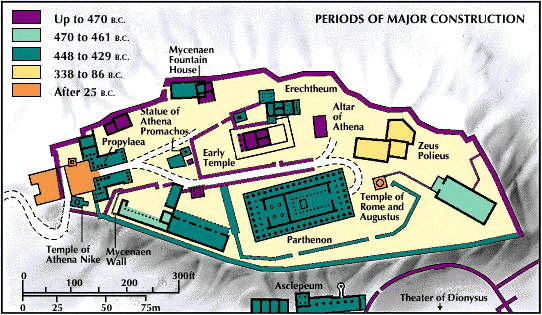Acropolis

Propylaea:
The impressive entrance, built during 437-432 BC on ancient propylaea ruins based on designs of the architect Mnesicles, and it is one of the masterpieces of classical architecture. Mnesicles gave the entrance a majestic touch resembling the one of the temples and altars that were situated on the Sacred Rock. They include a main space and two wings. The north wing was called Pinacotheke because it had been used as an exhibition spot for art work. The Doric order characterizes the external pillars -to the east and west- while internally, the entrance is framed by two tall Ionic colonnades. The brilliant combination of Doric and Ionic order from Mnesicles provokes an uplift and a high aesthetic emotion to the visitors.
During the 12th century the Propylaea are becoming the residence of the eparch Michail Choniatis. During the occupation by the Franks they acquire a floor and operate as a palace for the Frank archons. The tall Frankish tower which was built for observation reasons was demolished in 1874.
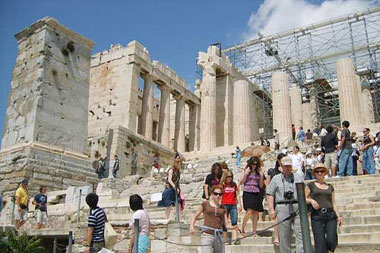
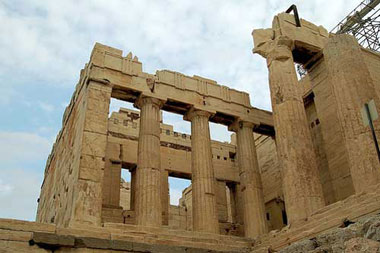
The Temple of Athena Nike:
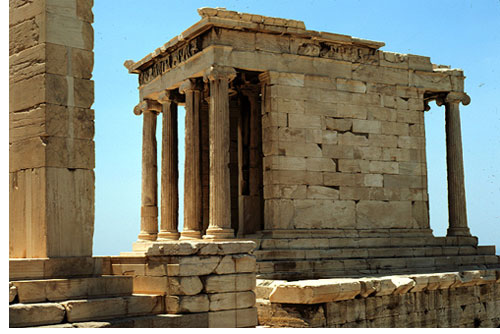
Small, elegant, Ionic temple built by Callicrates around 426-421 BC on a tower of the Mycenaean wall. It is dedicated to the Goddess Athena and the prehistoric goddess Nike, the protectress of the entrance. In 1686 it has been demolished by the Ottomans and assembled again after. The best view of the temple is from the Propylaea.
Vravronia Artemida Sanctuary:
It was situated to the southeast of the propylaea and it formed an archway with ten Doric pillars. Goddess Artemis was worshipped here. This worship had its roots to Vravrona, Peistratos' origin. Today, some particles of the foundations are saved.
Chalkotheke (copper case):
To the east of Vravronia Artemida sanctuary the foundations of another building of the 5th c BC are saved. This building is believed to be the chalkotheke used for the storage of valuable metal oblations.
Erechtheion:
You will find it on the northern side of the Sacred Rock. It is an elaborate, important and complicated temple in its construction. They began building it in 421 BC.
The mythical king Erechtheas who gave his name to the temple was identified with the chthonic demon Erichthonios and later on with Poseidon. A leading role among the other deities played Athena and Poseidon. At the same location Hephaestus and Voutis, the father and brother of Erechtheas were also worshipped.
The fountain with the sea water offered by Poseidon existed on the premises of the Erechtheion along with the ancient xoanon (statue) of Athena, while the sacred olive tree of the goddess was found on the west side.
The northern archway presents a particular interest with the impressive gate and the incomparable Ionic decoration from the bottom of the pillars to their top. The east side has an impressive line of six pillars and a frieze.
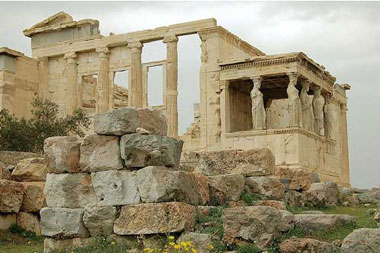
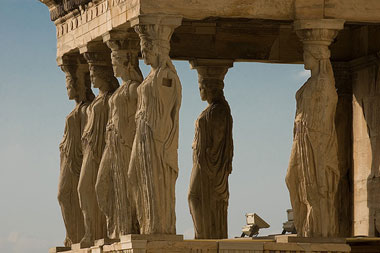
The six Caryatids supporting the entablature are an eternal symbol of female aesthetic perfection and remind us of a ritual. The original statues are found in the museum of the Acropolis. The Caryatids were identified as the young girls who danced with baskets on their heads in rituals dedicated to Artemis Caryatid.
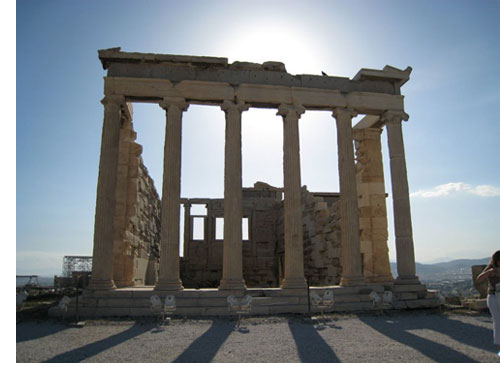
During the invasion of Silas in 86 BC, the Erechtheum suffered serious damages from a destructive fire. Later, during the 7th c BC it was transformed into a church dedicated to Our Lady. During the Frankish rule it has become a command post and during the ottoman domination it was a harem. In the beginning of the 19th c it is ravaged by the people of lord Elgin. For the reconstruction of the monument a special medal has been awarded by Europa Nostra in 1987.
Pandrosio, dedicated to Pandrosos, the daughter of Cecrops was situated on the western side of the Erechtheum.
Ancient temple:
In front of the Caryatids between the Erechtheum and the Parthenon are the ruins of an archaic temple of the 6th c BC dedicated to Athena Polias. The information that we have for the specific temple are vague and poor. Maybe this temple was situated at the same location from the geometric years at the same position with the palace of the Mycenaean era. The frieze sculptures of the Battle of the Giants" (gigantomachia) probably belong to this temple (525 BC). Now they are exhibited at the museum of the Acropolis.
Very close to the monuments mentioned before were the Arriforio, the altar of Athens, the sign of the earth, the altar of Zeus Polios and the temple of Rome August (after 27 BC).
